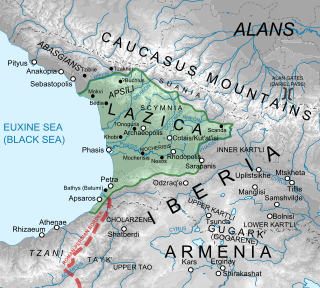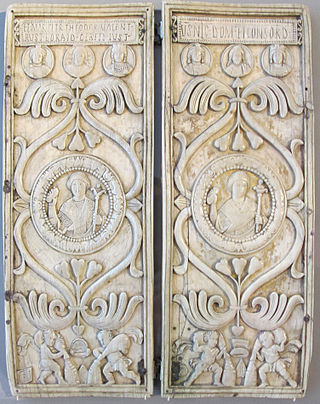The 550s decade ran from January 1, 550, to December 31, 559.

Year 537 (DXXXVII) was a common year starting on Thursday of the Julian calendar. At the time, it was known as the Second year after the Consulship of Belisarius. The denomination 537 for this year has been used since the early medieval period, when the Anno Domini calendar era became the prevalent method in Europe for naming years.

Year 544 (DXLIV) was a leap year starting on Friday of the Julian calendar. The denomination 544 for this year has been used since the early medieval period, when the Anno Domini calendar era became the prevalent method in Europe for naming years.
Year 555 (DLV) was a common year starting on Friday of the Julian calendar. The denomination 555 for this year has been used since the early medieval period, when the Anno Domini calendar era became the prevalent method in Europe for naming years.

The Lazic War, also known as the Colchidian War or in Georgian historiography as the Great War of Egrisi, was fought between the Byzantine Empire and the Sasanian Empire for control of the ancient Georgian region of Lazica. The Lazic War lasted for twenty years, from 541 to 562, and ended with the Fifty-Year Peace Treaty, which obligated the Byzantine Empire to pay tribute to Persia each year for the recognition of Lazica as a Byzantine vassal state by Persians. The Lazic War is narrated in detail in the works of Procopius and Agathias.
Adarmahān was a Persian general active in the western frontier of the Sassanid Empire against the East Roman (Byzantine) forces, during the Byzantine–Sassanid War of 572–591.

Flavius Mar. Petrus Theodorus Valentinus Rusticius Boraides Germanus Iustinus, simply and commonly known as Justin, was an Eastern Roman aristocrat and general. A member of the Justinian Dynasty and nephew of Emperor Justinian I, he was appointed as one of the last Roman consuls in 540, before going on to assume senior military commands in the Balkans and in Lazica. He fought against the Slavs, the Sassanid Persians and supervised the Byzantine Empire's first contacts with the Avars. At the time of Justinian's death, he was seen as a probable successor, but was beaten to the throne by his cousin, Justin II, who exiled him to Egypt, where he was murdered.
Justinian was a Byzantine aristocrat and general, and a member of the ruling Justinian dynasty. As a soldier, he had a distinguished career in the Balkans and in the East against Sassanid Persia. In his later years, he plotted unsuccessfully against regent and later emperor Tiberius II.
Cours or Curs, also known as Coursos, Cursos, Qwrys, Crous or Crus, was an East Roman (Byzantine) general of the 6th century.
Marcian was a Byzantine general and a kinsman of Emperor Justin II.
Hermogenes was an Eastern Roman official who served as magister officiorum, military commander and diplomatic envoy during the Iberian War against Sassanid Persia in the early reign of Emperor Justinian I.
Tamkhosrau or Tamkhusro, was a Sassanid Persian general active in the Roman–Persian Wars of the late 6th century. As his honorific name indicates, he was a highly regarded man among the Persians, and one of the chief generals of the shah Khosrau I.
Gubazes II was king of Lazica from circa 541 until his assassination in 555. He was one of the central personalities of the Lazic War (541–562). He originally ascended the throne as a vassal of the Byzantine Empire, but the heavy-handed actions of the Byzantine authorities led him to seek the assistance of Byzantium's main rival, Sassanid Persia. The Byzantines were evicted from Lazica with the aid of a Persian army in 541, but the Persian occupation of the country turned out to be worse, and by 548, Gubazes was requesting assistance from Byzantium. Gubazes remained a Byzantine ally during the next few years, as the two empires fought for control of Lazica, with the fortress of Petra as the focal point of the struggle. Gubazes eventually quarrelled with the Byzantine generals over the fruitless continuation of the war, and was assassinated by them.
Tzath II was King of Lazica as a Byzantine client from 556 to an unknown date.
Tzath I, Tzathius or Tzathios in Byzantine sources, was king of Lazica from 521/522 to an unknown date. He rejected Sassanid Persian overlordship and turned to the Byzantine emperor Justin I for aid. He was the first Christian king of Lazica.
Mihr-Mihroe, in Middle Persian either Mihr-Mihrōē or Mihrmāh-rōy; in Byzantine sources Mermeroes, was a 6th-century Sasanian general, and one of the leading commanders of the Byzantine–Sassanid Wars of the time.

The siege of Phasis took place in 555–556 during the Lazic War between the Byzantine and Sasanian Empires. Expecting an easy victory, the Persians besieged the town of Phasis in Lazica, held by the Byzantines, but were defeated in the ensuing irregular battle. The main source for the siege is the 6th-century historian Agathias.
Bessas was an Eastern Roman general of Gothic origin from Thrace, primarily known for his career in the wars of Justinian I. He distinguished himself against the Sassanid Persians in the Iberian War and under the command of Belisarius in the Gothic War, but after Belisarius' departure from Italy he failed to confront the resurgent Goths and was largely responsible for the loss of Rome in 546. Returning east in disgrace, despite his advanced age he was appointed as commander in the Lazic War. There he redeemed himself with the recapture of Petra, but his subsequent idleness led Justinian to dismiss him and exile him to Abasgia.
Fariburz, known in Byzantine sources as Phabrizus, was a 6th-century Iranian military officer from the Mihran family, who served under the Sasanian king Khosrau I.
The siege of Petra was fought in 550 AD, between the Byzantines under general Bessas, and the Sasanian Persian garrison of Petra in the buffer state of Lazica. The strategic fortress had previously been held by the Byzantines before it was seized in 541 by the Sasanian king Khosrow I, and his Lazi allies. This conquest gave the Sassanian Empire access to the Black Sea and marked the beginning of the Lazic War. After a failed attempt to recapture Petra in 549, the Byzantine emperor Justinian I sent an army under Bessas to retake the fortress. The Byzantine historian Procopius described the resulting siege in vivid detail.




